#wotan wagner
Text
Kind of got a fun little headcanon that there are actually WAY more people in the town of Edda who are fully aware of their status' as reincarnated gods and are just like: "Eh. It is what it is." and just go about their everyday lives as if nothing much has really changed with the occasional "YOU KNOW!" + "AND YOU KNOW!" moment spattered in.
I love this idea because it just makes Magne, Laurits and the others attempting to do hella sus shit in a completely unsubtle manner so much funnier when you imagine the handful of townsfolk, who always seem to be around for their shenanigans, just watching them and shaking their heads like: "Ah shit, Thor and Loki are back at it again."
#foxglovevibes#netflix ragnarok#ragnarok netflix#headcanons#magne seier#laurits seier#fjor jutul#saxa jutul#turid seier#vidar jutul#ran jutul#wotan wagner#iman reza#my own headcanon#norse mythology#norse paganism#norse gods#thor#loki#odin#freya
118 notes
·
View notes
Text



Discard your phones, ravens are in
24 notes
·
View notes
Link
You're going to lose your head.

*Also posted on ff.net.
*Inspired by a comment @babyboy-laurits made around 34 years ago.
#ragnarok netflix#ragnarok#erik eidsvoll#magne seier#wotan wagner#isolde eidsvoll#ragnarok fanfiction#not my image#read the warnings
1 note
·
View note
Photo

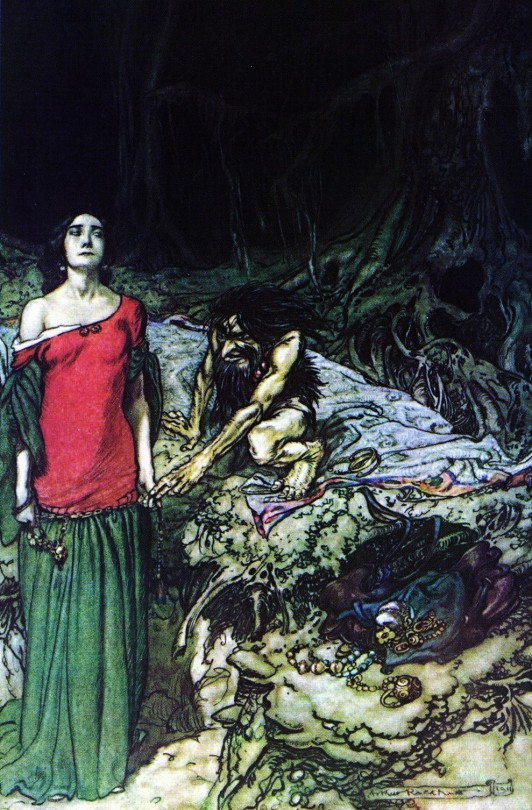

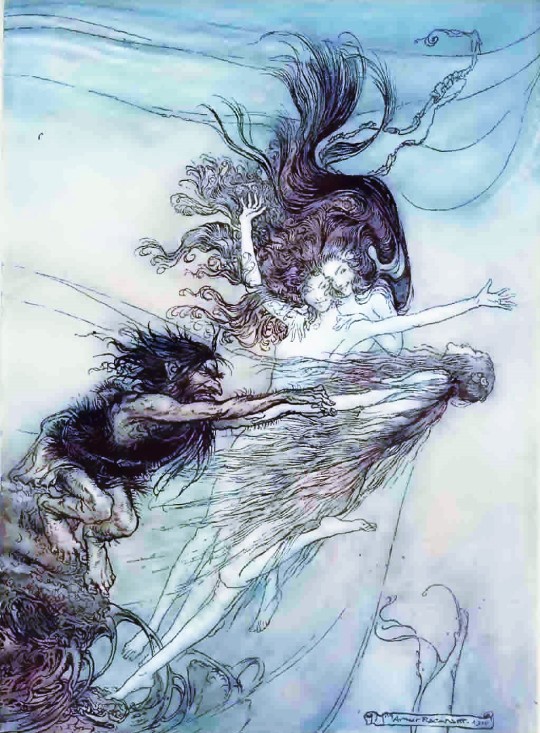
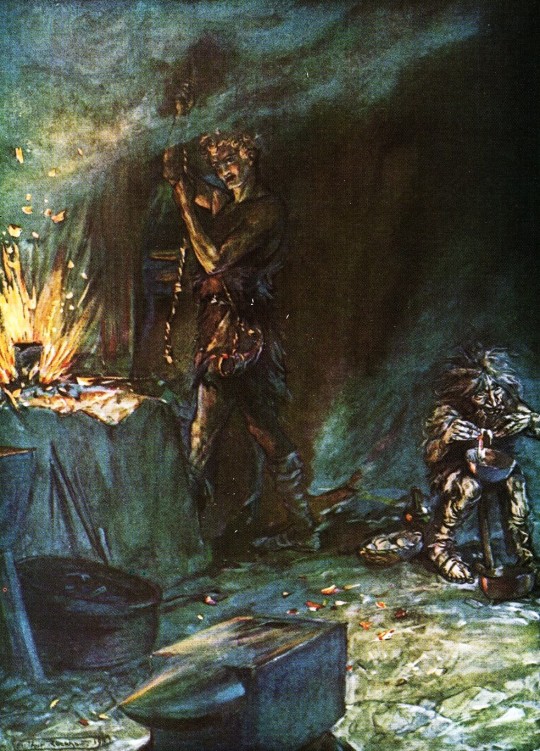


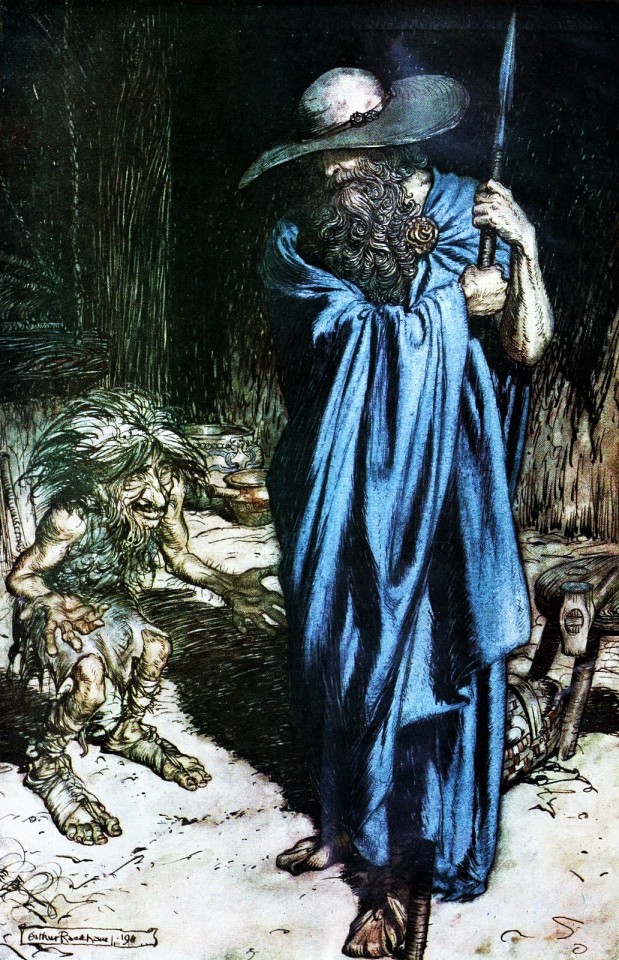


The Ring of the Nibelung - art by Arthur Rackham (1910-1911)
#arthur rackham#the ring of the nibelung#fantasy art#book illustrations#richard wagner#der ring des nibelungen#siegfried#norse gods#loki#brunnhilde#wotan#1910s#1910#1911
4K notes
·
View notes
Text
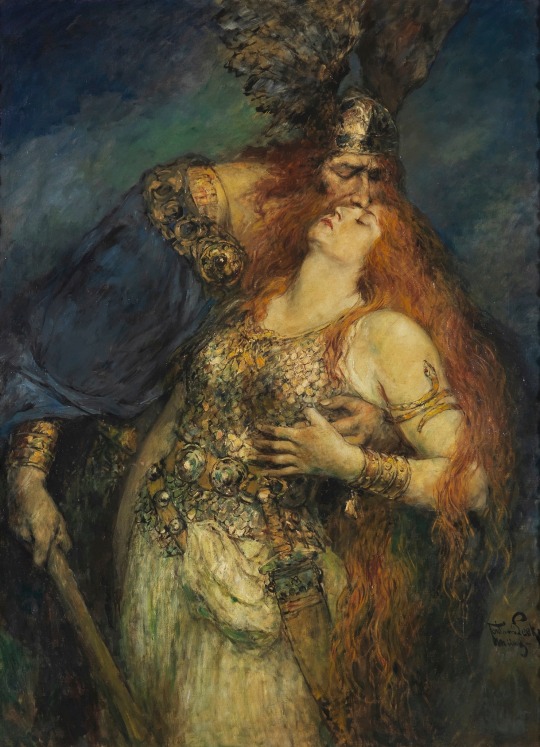
Wotan's farewell to Brunhilde by Ferdinand Leeke
#wotan#brunhilde#art#ferdinand leeke#die walküre#the valkyrie#richard wagner#odin#norse mythology#germanic mythology#der ring des nibelungen#the ring of the nibelung#mythology#religion#germanic#germany#german#nordic#norse#northern europe#europe#european#gods#mythological#woden
233 notes
·
View notes
Text
Broke: Ugly modern minimalist Wagner staging

Woke: Beautiful old-fashioned Wagner staging

Bespoke: FUTURISTIC PSYCHEDELIC SPACE WAGNER
I have slowly watched the Ring Cycle in the 2008 Valencia production over the last weekends. (It's also on YT, but without subtitles.) First time I watched the whole thing! I wanted something more traditional at first, but I happened upon an excerpt of this version and it just somehow appealed to me, so I watched this instead.
(I still agree with what I said on the topic earlier - if I didn't know anything about the source material, the Nibelungen and Norse mythology, I would have found this staging very confusing.)
Anyway, here's some pictures because it just looks so damn cool. Sorry the quality is not so great. DON'T click to enlarge! Believe me, you'll regret it.
THE NORNS:




Fricka argues with Wotan:

THE VALKYRIES:
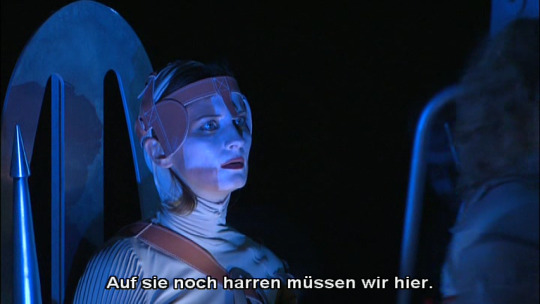




A talking bird:

This is what the inside of a dragon lair looks like:
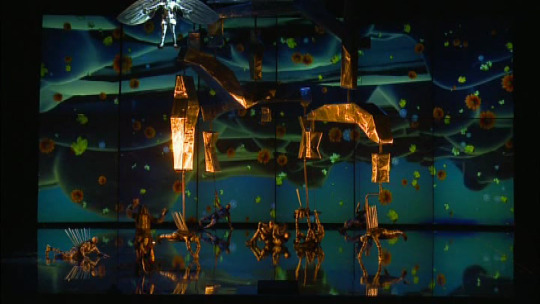
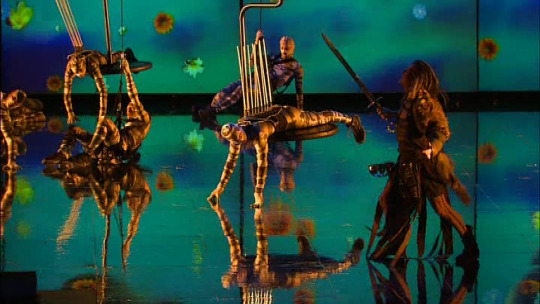
The scheming nobles / corrupt elite are investment bankers or something. First picture: Gutrune and Gunther. Second picture: Hagen and his men.


Alberich visits his son Hagen:

Brünnhilde in her wedding dress, having the worst day of her life in front of Rhine-waves made from empty plastic bottles:

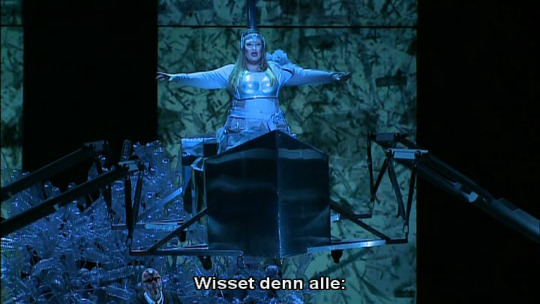
Mime in his chemistry lab (this must be REALLY confusing to anyone who doesn't know the story - why does he have an isolated chemistry lab in the forest? Originally he's a smith.):



Wotan and Mime talk about giants, which are visualized as battle mechs, I was so delighted!


Wotan, who was intensely dramatic for 16 hours straight:


The wall of fire around Brünnhilde's rock bed:

Gutrune always travels in her personal miniature death star:

Finally, Ragnarök:
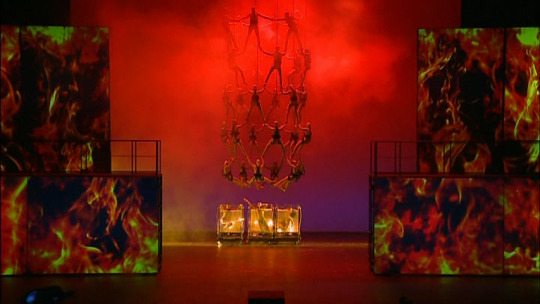
And those are the 30 pictures per post that I'm allowed.
#wagner#ring cycle#The Opera#norse mythology#music stuff#opera#siegfried#brünnhilde#wotan#germanic mythology
27 notes
·
View notes
Text
From Das Rheingold, the first opera in The Ring Cycle by Richard Wagner:
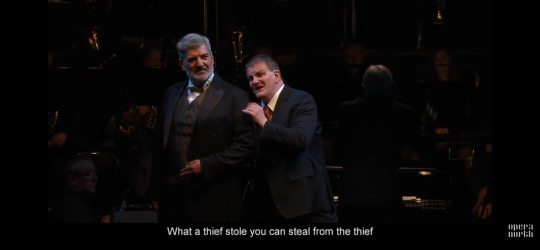
Lina Inverse would be proud!

“Bandits don’t have any rights!”
(I’m paraphrasing from memory, but that’s her rationale…)
#das rheingold#the ring cycle#opera#richard wagner#wotan#loge#lina inverse#the slayers#slayera#it ain’t stealing#if you’re stealing from bad guys!
4 notes
·
View notes
Text
Just finished setting supertitles for Das Rheingold and like... Loki just gets the shaft in every story he's in, doesn't he? Between literally no one listening to him about returning the gold to the Rheinmaidens and Wotan flatly saying "I'm your only friend and even I don't like you sometimes." like...
Also it's funny that Wagner had him say that he's "not made for hearth and home" when he has at least 2 wives and 6+ kids XD
17 notes
·
View notes
Text
Wotan: 'For one alone winneth the bride; one freer than I, the god!' (Patrice Chéreau, Bayreuth)
Wotan
For one alone winneth the bride;
one freer than I, the god!
The Ring of the Nibelung
(Denn Einer nur freie die Braut,
der freier als ich, der Gott!)
Richard Wagner,
Der Ring des Nibelungen: Die Walküre
Bayreuth 1979,
Patrice Chéreau / Pierre Boulez
Gwyneth Jones: Brünnhilde
Donald McIntyre: Wotan
#art#opera#music#richard wagner#singer#the ring#classical music#love#wagner#goddess#god#daughter#father#patrice chéreau#bayreuth#brunnhilde#wotan#pierre boulez#the ring of the nibelung#der ring des nibelungen#die walküre
1 note
·
View note
Text
Ragnarok is extremely good at referring back to norse mythos and translating specific things less known in said mythos to the screen but here are a few things I would have LOVED for them to touch on or refer to;
- Loki and Thor both being redheads in the original norse texts
I just feel like it was a bit of a missed opportunity to do what a lot of modern interpretations of Thor and Loki have done, in letting the fact that the two both have red hair fall to the wayside. (Quick little shout out to God of War for being one of the first instances where I've seen that particular trait kept within their character designs-)
The feature itself was often heavily noted upon anywhere Thor and Loki were concerned. So much so that I'm fairly certain it was one of the reasons why their initial relationship, that of an uncle (Loki) and a nephew (Thor), eventually evolved culturally into that of surrogate siblings.
It also served to highlight just how similar the two actually were. Most notably in how tempestuous both their tempers could be and how prideful they both are as well. Not to mention it would serve as a highlight of the disparity between Thor's less than stellar actions being glorified while Loki's are denounced as tricks and leave him villified.
Not to mention from a story telling standpoint, it would have made the reveal that Laurits is actually Vidar's son and not Asbjørn's a bit less easy to clock but I digress.
- An acknowledgment of a majority of the more notable Aesir having Jotunn ancestry
In terms of the way the show was written, it is understandable that this particular tidbit of info wasn't exactly included.
But it really would have added an interesting take to how Laurits interacted with the other gods, particularly where his more direct connection to the Jotunn in this life was concerned. Because some of the most famous of the Aesir either had direct genealogical or inherited links to the Jotnar in the original myths. Thor, Tyr, Heimdall and even Odin himself to name a few.
So the hypocritical stance the gods (Wotan in particular-) took against Laurits in initially shunning him away for being both Loki in his past life and having direct Jotunn ancestry in this life really would have just nailed home how fickle the other gods truly are. A fact that would have made their eventual turn against Magne for losing his abilities, when he was the one to start the fight against the Jutuls, feel even more like a stab in the back.
- More references to Angrboða and the other children she had with Loki
This is mainly just a little gripe I'd had with the show, in the fact that they all but ignored just how significant Angrboða's union with Loki truly was and what their children endured at the hands of the Aesir simply for being born, especially Fenrir.
I do understand it was due to Laurits being gay in the show (as well as a teenager) but I honestly can't help but feel that they made him so as a way to not have to stress too much about tackling the modern creation stories of Fenrir and Hel. Which sucks because the way they brought Jormungandr to life was genuinely a really interesting take on things.
This is all just my opinion though, if you have differing ones that's more than fine!
#foxglovevibes#netflix ragnarok#ragnarok netflix#ragnarok#magne seier#laurits seier#turid seier#fjor jutul#saxa jutul#wotan wagner#iman reza#ran jutual#vidar jutul
14 notes
·
View notes
Photo
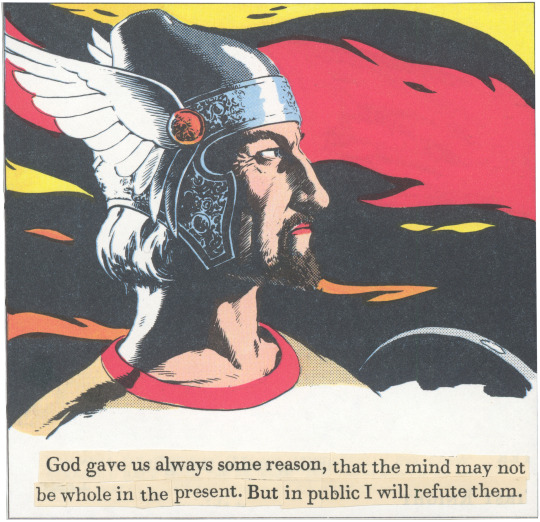
WOTAN (II), 2022. 4 ½" x 4 ½"
0 notes
Text
I'm now reading another of Heidi Ann Heiner's fairy tale collections. Sleeping Beauties: Sleeping Beauty and Snow White Tales from Around the World. Since I enjoyed Cinderella Tales from Around the World so much, I couldn't resist opening another of Heiner's books.
The first part of the book is devoted to the different international versions of Sleeping Beauty, the second part to the different versions of Snow White. This is followed by other tales of "sleeping beauties" that don't fit nearly into either category.
We start with the medieval Sleeping Beauty prototype tales from the 13th and 14th centuries.
*The earliest known prototype of the Sleeping Beauty story is the Norse and Germanic legend of Brynhild (a.k.a. Brunhild, Brunhilda, Brünnhilde, or other variations). This legend first appears in the Poetic Edda, the Prose Edda, and the Volsunga Saga from 13th century Iceland. It also appears in the German Nibelungenlied (although that version doesn't include the enchanted sleep), and its most famous modern adaptation is in Richard Wagner's four-opera cycle Der Ring des Nibelungen. The figure of Brynhild also inspired the Marvel superheroine Valkyrie.
**The Sleeping Beauty-like portion of the legend is this. The beautiful and strong-willed Brynhild is one of the valkyries, the warrior maiden servants (and in some versions daughters) of Odin (or Woden, Wotan, etc.) who preside over battlefields and bring the souls of fallen heroes to Valhalla. But Brynhild disobeys Odin by saving (or trying to save) the life of a warrior who was marked for death. (The man's identity, why he was meant to die, why she defends him, and whether she succeeds in saving him or not varies between versions.) As punishment, Odin banishes her to the mortal realm, pricks her with a "sleep thorn," and places her in a castle (or just on a rock) surrounded by a ring of fire, condemning her to sleep until a man brave enough to venture through the flames arrives to wake her and become her husband. (In some versions, she has attendants and servants who all sleep along with her.) Many years later, the fearless hero Sigurd, or Siegfried, succeeds in passing unharmed through the flames and wakes Brynhild by cutting off her valkyrie armor (or in later retellings influenced by Sleeping Beauty, with a kiss). The couple doesn't live happily ever after, however: their further adventures and eventual tragic fates are a story for another day.
**Even though it's a well-known fact that in "the original Sleeping Beauty stories," the prince (or his counterpart) impregnates the sleeping heroine and she wakes after she gives birth, no such thing happens in this earliest proto-version. If we assume that this really is the Western world's first tale of a heroine in an enchanted sleep, then it seems as if that sordid detail was a later addition.
*Next in Heiner's book come several medieval French Sleeping Beauty tales, mostly from Arthurian romances. These are the tales where we first see the motif of the heroine's love interest raping her in her sleep and fathering a child. Since few of them have ever been translated into modern English, the book simply summarizes them instead of printing them in full.
**The best-known of these stories, which most resembles Sleeping Beauty as we know it today, is the tale of Troylus and Zellandine from Le Roman de Perceforest, an Arthurian romance from 14th or 15th century France. In this tale, a knight named Troylus loves a princess named Zellandine. Then learns that while spinning, Zellandine has suddenly fallen into a deep sleep, from which no one can wake her. With the help of a spirit named Zephir and the goddess Venus, Troylus enters the tower where she lies and, at Venus's urging, he takes her virginity. Nine months later, Zellandine gives birth to a son, and when the baby sucks on her finger, she wakes. Zellandine's aunt now arrives, and reveals the whole backstory, which only she knew. When Zellandine was born, the goddesses Lucina, Themis, and Venus came to bless her. As was customary, a meal was set out for the three goddesses, but then the room was left empty so they could enter, dine, and give their blessings unseen; but the aunt hid behind the door and overheard them. Themis received a second-rate dinner knife compared to those of the other two, so she cursed the princess to someday catch a splinter of flax in her finger while spinning, fall into a deep sleep, and never awaken. But Venus altered the curse so that it could be broken and promised to ensure that it would be. When the baby sucked Zellandine's finger, he sucked out the splinter of flax. Eventually, Zellandine and Troylus reunite, marry, and become ancestors of Sir Lancelot.
***This tale provides some answers for questions that the traditional Sleeping Beauty raises. In the familiar tale, the king, the queen, and their court know about the curse, so why do they keep it a secret from the princess? Yes, they avoid upsetting her by doing so, but the end result is that when she finally sees a spindle, she doesn't know to beware of it. Why not warn her? And why is there a random old woman in the castle, spinning with presumably the kingdom's one spindle that wasn't destroyed, and why, despite living in the castle does she not know about the curse? (It's no wonder that most adaptations make her the fairy who cursed the princess in disguise.) Yet in this earlier version, there are no such questions: no one except the eavesdropping aunt knows about the curse, because it was cast in private, so no one can take precautions against it. Another standout details is the fact that Zellandine's sleep doesn't last for many years, and that the man who wakes her already loved her before she fell asleep. Disney didn't create those twists after all!
**The other medieval French Sleeping Beauty tales are Pandragus and Libanor (where Princess Libanor's enchanted sleep only lasts one night, just long enough for Pandragus to impregnate her), Brother of Joy and Sister of Pleasure (where the princess isn't asleep, but dead – yet somehow the prince still impregnates her – and is revived by an herb that a bird carries to her), and Blandin de Cornoalha (a knight who, refreshingly, doesn't impregnate the sleeping maiden Brianda, but breaks her spell by bringing a white hawk to her side).
*All of these early Sleeping Beauty tales are just one part of bigger poetic sagas. Maybe this explains why Sleeping Beauty is fairly light on plot compared to other famous fairy tales (i.e. we're told what's going to happen, and then it does happen, and it all seems inevitable from the start). Of course one argument is that it's a symbolic tale: symbolic of a young girl's coming-of-age, as the princess's childhood ends when she falls asleep and her adulthood begins when she wakes, and/or symbolic of the seasons, with the princess as a Persephone-like figure whose sleep represents winter and whose awakening represents spring. That's all valid. But maybe another reason for the flimsy plot is that the earliest versions of the tale were never meant to stand alone. They were just episodes in much longer and more complex narratives.
@ariel-seagull-wings, @adarkrainbow, @themousefromfantasyland
#sleeping beauty#fairy tale#variations#sleeping beauties: sleeping beauty and snow white tales from around the world#heidi ann heiner#norway#iceland#germany#norse mythology#france#england#italy#tw: rape#tw: cannibalism
38 notes
·
View notes
Text
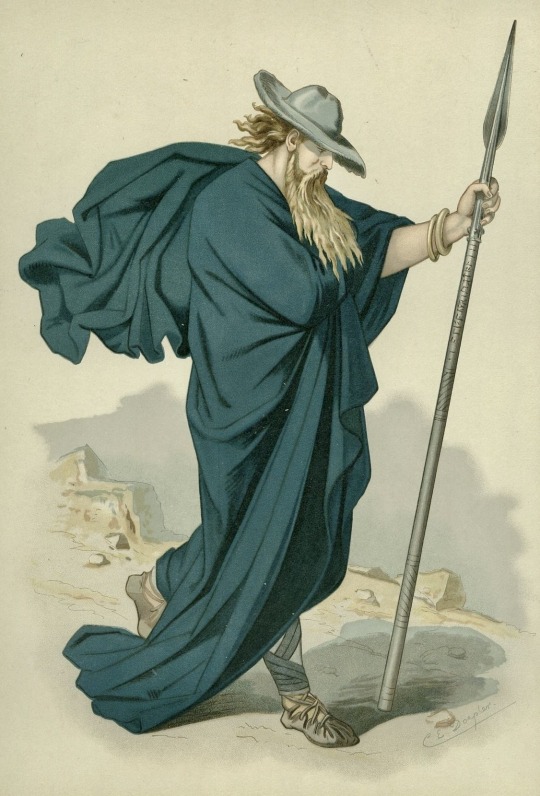
Wotan by Carl Emil Doepler, illustration from Der Ring des Nibelungen von Richard Wagner: Figurinen Erfunden und Gezeichnet (The Ring of the Nibelung by Richard Wagner: Figurines Invented and Drawn) (1889)
481 notes
·
View notes
Text

#der ring des nibelungen#richard wagner#die walküre#the valkyrie#germanic#mythology#norse#norse mythology#northern europe#europe#european#history#art#knut ekwall#brünnhilde#wotan#hunding#nothung#sword#sigmund#death#combat#gods#sieglinde#valkyrie#odin#opera#germanic heroic legend#the ring of the nibelung#siegmund
186 notes
·
View notes
Text
Opera stream alert!!

What? Das Rheingold, the Copenhagen production
Time? 6th march 19.00 CET
English subs? Yes!
Naked man in aquarium? Yes! You will see his dongdong and everything!
Who is welcome? Everyone and anyone, as long as you're polite. :)
I saw this production when I was a teenager, it was.... a formative experience. Rewatching it was superfun. You will get mad scientists, Albrecht turns into a marshmallow, Wotan is a bit too much into torture, and these people really shouldve made sure they had the funds to build their house before contracting some guys to build it.
Also taking potshots at Wagner is welcomed and appreciated. I'm all for getting new reasons to hate the guy.
EDIT: forgot to add kosmilink
18 notes
·
View notes
Text
Dainsleif and The Ring of the Nibelung
Since I'm very fixated on finding out more about the mysteries of Khaenri'ah, this line has been brewing in the backburner of my mind since this world quest came out:

Zurvan was talking about Dain emerging from the cataclysm 500 years ago. Before then, he had never mentioned a ring, which got me curious as to what it could possibly be referring to?
I did a quick search and came across 'Der Ring des Nibelungen', or The Ring of the Nibelung; a very famous epically long 4 part opera by Wagner. It is indeed, about an actual ring.
The opera is inspired by Nordic mythology, using various characters whose names we have encountered that are connected to Khaenri'ah.
In the story, the ring is stolen and ends up cursed by its forger, Alberich, who in Norse mythology is typically a dwarf. What's interesting is that the gold to forge the ring was ALSO stolen from...the RHINEGOLD. (Rhinedottir, AKA, GOLD)
The Rhinegold, when forged into a ring, gives the owner the power to rule over the world, but only if love is renounced. Thus this ring is heavily sought after during the epic opera for a number of reasons.
Given that this ring holds significant power in the opera, I don't see why the ring clutched in Dain's hand wouldn't also hold power as well. Likely...some kind of power from beyond this world? The kind of power that Rhinedottir loved to mess with?
If that's the case, what the heck is Dain doing with it? And where is it now? He seems to have mystery hiding places (Like wherever he put the OG Field Tiller eye), and given that the ring is nowhere to be seen on his person, it may be hidden as well.
Before, I mentioned that the ring Alberich forged was stolen from him. It was taken by Wotan to be used as a bargaining chip to a pair of giants he owed a debt to. If the ring in Genshin lore contains the power of forbidden knowledge, Rhinedottir may have not forged the ring, but created it through alchemy. It's possible that Dain may have stolen the ring from Rhinedottir, knowing it contained the forbidden knowledge that led to the demise of Khaenri'ah. Given that the ring was clutched in his hand instead of worn on his hand, this implies he may have grabbed it in haste.
Without more information, however, I can only speculate the significance of the ring being in Dain's possession, or what power it may possess.
Another interesting little tidbit I read was that at the end of Act I of The Ring, the Rhinemaidens were pretty upset at their stolen gold, and (at least according to wiki) "condemn the gods as false and cowardly." Given that the Rhinemaidens dwelled at the bottom of the Rhine river, (and Khaenri'ah was an underground kingdom) there's a definite correlation to the relationship of Khaenri'ahns versus the gods and Celestia.
These parallels to "The Ring" and Khaenri'ah also opens the possibility of a connection to the Dragon King, ALSO named "Nibelung." But that's a whole other post for another day.
39 notes
·
View notes